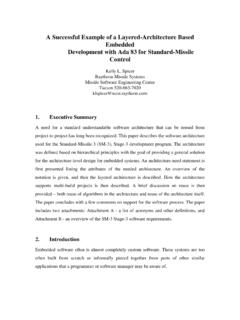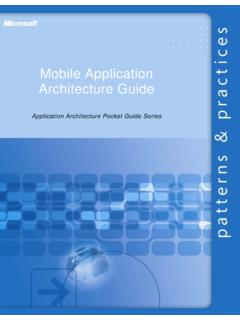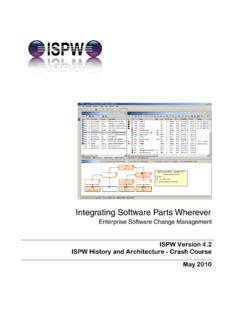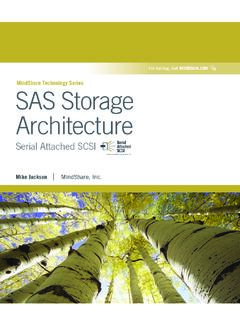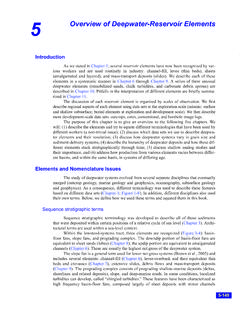Transcription of Clarified CQRS - Udi Dahan
1 Page 1 Clarified cqrs Udi Dahan - The Soft ware Simpli st After listening how the community has interpreted Command-Query Responsibility Segregation I think that the time has come for some clarification. Some have been tying it together to Event Sourcing. Most have been overlaying their previous layered architecture assumptions on it. Here I hope to identify cqrs itself, and describe in which places it can connect to other patterns. Why cqrs Before describing the details of cqrs we need to understand the two main driving forces behind it: collaboration and staleness. Collaboration refers to circumstances under which multiple actors will be using/modifying the same set of data whether or not the intention of the actors is actually to collaborate with each other. There are often rules which indicate which user can perform which kind of modification and modifications that may have been acceptable in one case may not be acceptable in others.
2 We ll give some examples shortly. Actors can be human like normal users, or automated like software. Staleness refers to the fact that in a collaborative environment, once data has been shown to a user, that same data may have been changed by another actor it is stale. Almost any system which makes use of a cache is serving stale data often for performance reasons. What this means is that we cannot entirely trust our users decisions, as they could have been made based on out-of-date information. Standard layered architectures don t explicitly deal with either of these issues. While putting everything in the same database may be one step in the direction of handling collaboration, staleness is usually exacerbated in those architectures by the use of caches as a performance-improving afterthought. Page 2 A picture for reference I ve given some talks about cqrs using this diagram to explain it: The boxes named AC are Autonomous Components.
3 We ll describe what makes them autonomous when discussing commands. But before we go into the complicated parts, let s start with queries: Queries If the data we re going to be showing users is stale anyway, is it really necessary to go to the master database and get it from there? Why transform those 3rd normal form structures to domain objects if we just want data not any rule-preserving behaviors? Why transform those domain objects to DTOs to transfer them across a wire, and who said that wire has to be exactly there? Why transform those DTOs to view model objects? In short, it looks like we re doing a heck of a lot of unnecessary work based on the assumption that reusing code that has already been written will be easier than just solving the problem at hand. Let s try a different approach: How about we create an additional data store whose data can be a bit out of sync with the master database I mean, the data we re showing the user is stale anyway, so why not reflect in the data store itself.
4 We ll come up with an approach later to keep this data store more or less in sync. Now, what would be the correct structure for this data store? How about just like the view model? One table for each view. Then our client could simply SELECT * FROM MyViewTable (or possibly pass in an ID Page 3 in a where clause), and bind the result to the screen. That would be just as simple as can be. You could wrap that up with a thin facade if you feel the need, or with stored procedures, or using AutoMapper which can simply map from a data reader to your view model class. The thing is that the view model structures are already wire-friendly, so you don t need to transform them to anything else. You could even consider taking that data store and putting it in your web tier. It s just as secure as an in-memory cache in your web tier.
5 Give your web servers SELECT only permissions on those tables and you should be fine. Query Data Storage While you can use a regular database as your query data store it isn t the only option. Consider that the query schema is in essence identical to your view model. You don t have any relationships between your various view model classes, so you shouldn t need any relationships between the tables in the query data store. So do you actually need a relational database? The answer is no, but for all practical purposes and due to organizational inertia, it is probably your best choice (for now). Scaling Queries Since your queries are now being performed off of a separate data store than your master database, and there is no assumption that the data that s being served is 100% up to date, you can easily add more instances of these stores without worrying that they don t contain the exact same data.
6 The same mechanism that updates one instance can be used for many instances, as we ll see later. This gives you cheap horizontal scaling for your queries. Also, since your not doing nearly as much transformation, the latency per query goes down as well. Simple code is fast code. Data modifications Since our users are making decisions based on stale data, we need to be more discerning about which things we let through. Here s a scenario explaining why: Let s say we have a customer service representative who is one the phone with a customer. This user is looking at the customer s details on the screen and wants to make them a preferred customer, as well as modifying their address, changing their title from Ms to Mrs, changing their last name, and indicating that they re now married. What the user doesn t know is that after opening the screen, an event arrived from the billing department indicating that this same customer doesn t pay their bills they re delinquent.
7 At this point, our user submits their changes. Should we accept their changes? Page 4 Well, we should accept some of them, but not the change to preferred , since the customer is delinquent. But writing those kinds of checks is a pain we need to do a diff on the data, infer what the changes mean, which ones are related to each other (name change, title change) and which are separate, identify which data to check against not just compared to the data the user retrieved, but compared to the current state in the database, and then reject or accept. Unfortunately for our users, we tend to reject the whole thing if any part of it is off. At that point, our users have to refresh their screen to get the up-to-date data, and retype in all the previous changes, hoping that this time we won t yell at them because of an optimistic concurrency conflict.
8 As we get larger entities with more fields on them, we also get more actors working with those same entities, and the higher the likelihood that something will touch some attribute of them at any given time, increasing the number of concurrency conflicts. If only there was some way for our users to provide us with the right level of granularity and intent when modifying data. That s what commands are all about. Commands A core element of cqrs is rethinking the design of the user interface to enable us to capture our users intent such that making a customer preferred is a different unit of work for the user than indicating that the customer has moved or that they ve gotten married. Using an Excel-like UI for data changes doesn t capture intent, as we saw above. We could even consider allowing our users to submit a new command even before they ve received confirmation on the previous one.
9 We could have a little widget on the side showing the user their pending commands, checking them off asynchronously as we receive confirmation from the server, or marking them with an X if they fail. The user could then double-click that failed task to find information about what happened. Note that the client sends commands to the server it doesn t publish them. Publishing is reserved for events which state a fact that something has happened, and that the publisher has no concern about what receivers of that event do with it. Commands and Validation In thinking through what could make a command fail, one topic that comes up is validation. Validation is different from business rules in that it states a context-independent fact about a command. Either a command is valid, or it isn t. Business rules on the other hand are context dependent.
10 In the example we saw before, the data our customer service rep submitted was valid, it was only due to the billing event arriving earlier which required the command to be rejected. Had that billing event not arrived, the data would have been accepted. Even though a command may be valid, there still may be reasons to reject it. Page 5 As such, validation can be performed on the client, checking that all fields required for that command are there, number and date ranges are OK, that kind of thing. The server would still validate all commands that arrive, not trusting clients to do the validation. Rethinking UIs and commands in light of validation The client can make of the query data store when validating commands. For example, before submitting a command that the customer has moved, we can check that the street name exists in the query data store.
